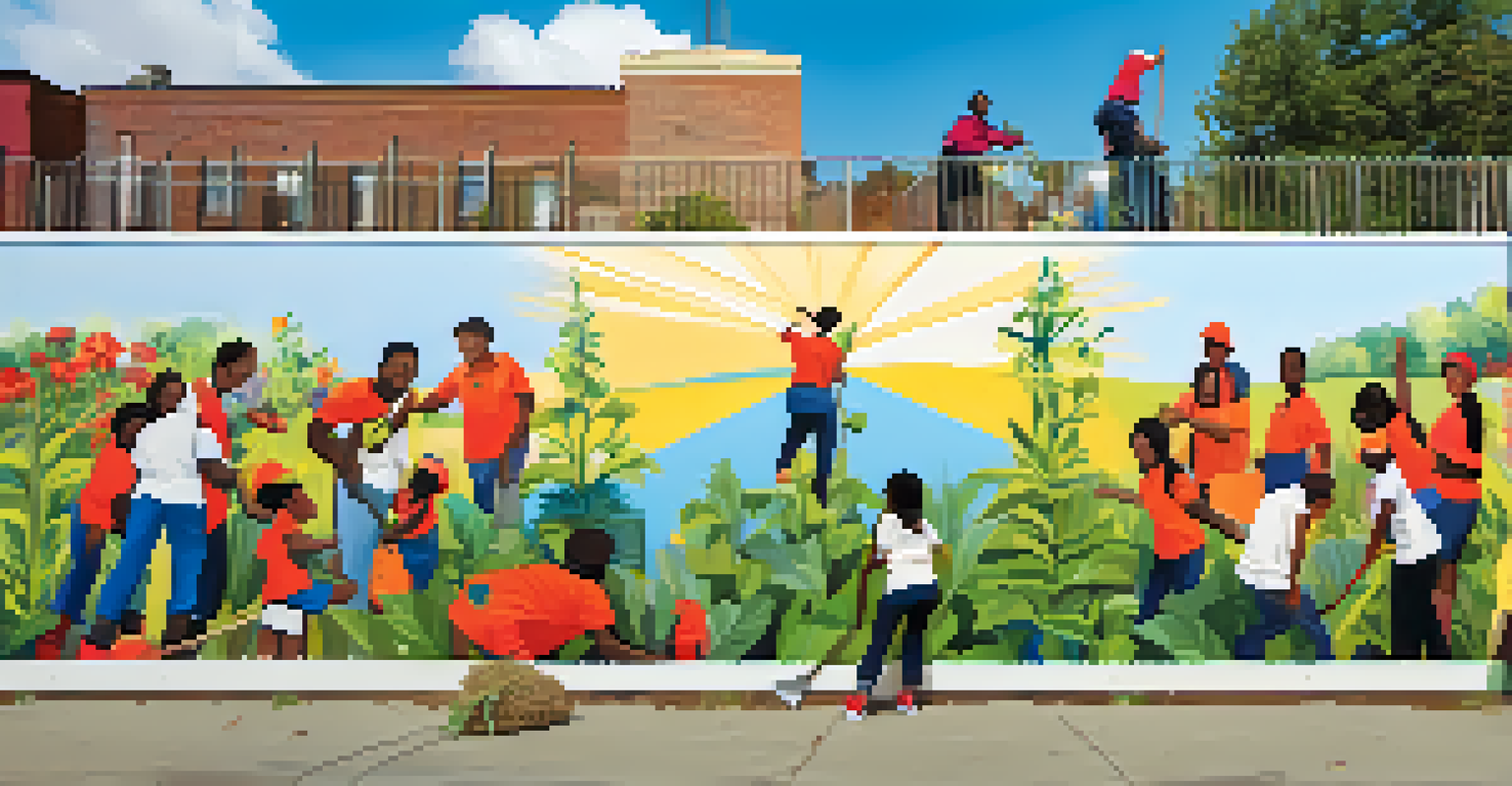Building Resilience Through Volunteer Work and Community

Understanding Resilience: The Power Within Us
Resilience is often defined as our ability to bounce back from challenges. It’s not just about enduring tough times; it’s about growing stronger through adversity. This inner strength helps us navigate life's ups and downs with a sense of hope and purpose.
Resilience is not about avoiding stress, but about learning how to thrive in the face of it.
When we face difficulties, whether personal or communal, resilience allows us to adapt and find solutions. It’s like a muscle that gets stronger with use. Just as lifting weights builds physical strength, overcoming emotional and psychological hurdles enhances our resilience.
Building resilience is a journey, not a destination. It involves developing coping strategies, fostering social connections, and often, engaging with our communities in meaningful ways. This is where volunteer work comes into play, creating opportunities for growth and connection.
The Role of Volunteer Work in Building Resilience
Volunteering serves as a powerful catalyst for building resilience. When we help others, we gain perspective on our own challenges, often realizing that we are not alone. This shared experience can be incredibly uplifting, fostering a sense of belonging and purpose.

Engaging in volunteer work can also enhance our problem-solving skills. As we face various challenges in helping others, we learn to think creatively and adaptively. This increased adaptability is a key component of resilience, equipping us to handle our personal trials more effectively.
Resilience Grows Through Adversity
Resilience is not just about enduring tough times; it’s about emerging stronger and more adaptable through life's challenges.
Moreover, volunteering strengthens our emotional intelligence. By interacting with diverse groups, we develop empathy and understanding, which further enrich our relationships. These connections are vital for resilience as they provide support during tough times.
Community Engagement: A Pillar of Resilience
Community engagement goes hand in hand with volunteering, creating a robust support network. When we connect with others, we share resources, knowledge, and experiences that can help us all navigate challenges. This sense of community becomes a safety net during difficult times.
Alone we can do so little; together we can do so much.
Being part of a community fosters a sense of accountability and shared responsibility. When we work together towards common goals, we cultivate a collective resilience that can withstand external pressures. It’s like a sturdy bridge made stronger by each supporting beam.
Additionally, communities that actively engage their members tend to thrive. This thriving environment not only boosts individual resilience but also enhances the overall well-being of the community. Together, we are stronger, and together, we can overcome.
Personal Growth Through Volunteering Experiences
Volunteering offers unique opportunities for personal growth and self-discovery. As we step outside our comfort zones, we learn new skills, gain confidence, and develop a sense of agency. Each experience enriches our lives and contributes to our resilience.
Consider the story of someone who volunteers at a local food bank. Initially, they may feel overwhelmed, but with time, they learn to manage tasks, coordinate efforts, and communicate effectively. These skills not only aid in their volunteer work but also transfer to personal and professional realms.
Volunteering Enhances Personal Growth
Engaging in volunteer work fosters personal development, equipping individuals with skills and confidence that bolster their resilience.
This personal development through volunteering can be transformative. As we face challenges and adapt to new situations, we build a toolkit of skills and strategies that fortify our resilience. Each step taken in service of others is a step toward becoming more resilient ourselves.
The Ripple Effect: Inspiring Others Through Service
One of the most beautiful aspects of volunteering is its ability to inspire others. When we engage in acts of service, we encourage those around us to do the same. This creates a ripple effect that can strengthen the fabric of our communities and promote resilience on a broader scale.
Imagine a neighborhood where one person organizes a clean-up day. This small act can motivate others to join in, fostering a sense of camaraderie and shared purpose. It transforms individual efforts into collective action that benefits everyone involved.
Inspiring others through our actions not only builds resilience in our communities but also cultivates a culture of support and encouragement. When we see others overcoming challenges and contributing positively, we are reminded of our own capacity for resilience and growth.
Connecting with Diverse Perspectives Through Volunteering
Volunteering often exposes us to individuals from diverse backgrounds and experiences. This interaction enriches our understanding of the world and broadens our perspectives. Embracing diversity helps us become more adaptable and open-minded, essential traits for resilience.
For instance, volunteering in a multicultural setting allows us to learn from others’ experiences and challenges. This exchange of ideas fosters empathy and compassion, helping us navigate our own difficulties with a more nuanced understanding.
Community Connection Builds Strength
Active community engagement creates a support network that enhances collective resilience, transforming individual efforts into shared success.
By connecting with different perspectives, we enhance our emotional resilience. We learn to appreciate varied approaches to problem-solving and coping strategies, which can be invaluable when we face our own challenges. It’s a reminder that there’s strength in diversity.
Conclusion: Cultivating Resilience Through Community and Service
In conclusion, building resilience through volunteer work and community engagement is a powerful journey. Each act of service not only strengthens our own resilience but also uplifts those around us. It creates a cycle of support, growth, and connection that benefits everyone involved.
As we navigate our lives, let’s remember the importance of giving back. Volunteering is not just about helping others; it’s about enriching our own lives and fostering resilience in the process. Each small effort counts and can lead to significant change.

So, whether you’re mentoring a child, helping at a local shelter, or organizing community events, know that you’re contributing to something greater. Together, we can build resilient communities capable of facing any challenge that comes our way.